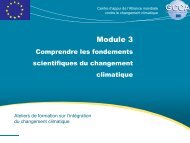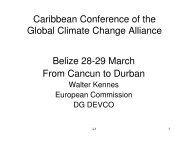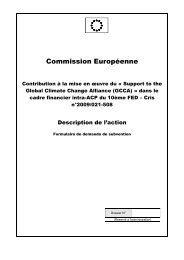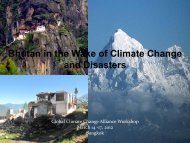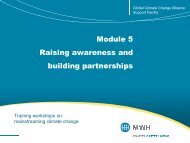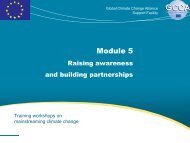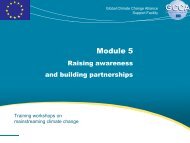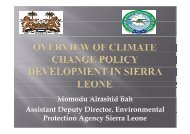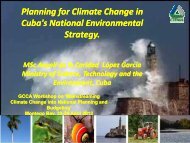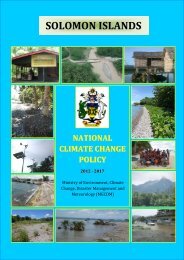Rwanda Green Growth Strategy 18nov11 - Global Climate Change ...
Rwanda Green Growth Strategy 18nov11 - Global Climate Change ...
Rwanda Green Growth Strategy 18nov11 - Global Climate Change ...
You also want an ePaper? Increase the reach of your titles
YUMPU automatically turns print PDFs into web optimized ePapers that Google loves.
Chapter 6Roadmap to ImplementationChapter 6: Roadmap to ImplementationThis <strong>Strategy</strong> is the first attempt at plotting a climate resilient and low carbon development pathway.It is the start of a continuous process which is described in the Enabling Pillars and will be implementedthrough the Programmes of Action. The first step (Figure 17) is to set up the institutional arrangements,namely the Technical Coordinating Committee, FONERWA and the Centre for <strong>Climate</strong> Knowledge forDevelopment. These government institutions will utilise the Sector Wide Approach and work closely withdevelopment partners, civil society, academia and the private sector. Implementation will be impossiblewithout the technical and financial support of these partners.The Technical Coordinating Committee will be responsible for implementation of the <strong>Strategy</strong> andfacilitate its incorporation into Vision 2020, EDPRS II and sector policies. Further work is then required toperform cost-benefit analysis on the programmes of actions and apply for climate finance for them. This willinform the revision of detailed sector strategies and annual budgets. In parallel, short term capacity buildingprogrammes must be initiated and work done to develop a long term plan to provide the support requiredto implement the <strong>Strategy</strong>.Figure 17 illustrates the steps that need to be taken in the coming years to mainstream climate resilienceand low carbon development at all levels of government. In order to achieve the 2050 vision,implementation must be an ongoing process (Figure 18) that responds to changes in climate,demographics, economic development, and global energy trends. Decisions need to be based on gooddata and research provided by government, academia, NGOs, private sector and development partners.This will allow a range of policy options to be considered and short to long term decisions made that benefitall <strong>Rwanda</strong>ns. The policies will then be translated into programme design and planning which are alsoinformed by the data and research available and robust economic analysis. Finally projects will beimplemented and monitoring and evaluation undertaken with findings then fed back into each step of theprocess.Set upinstitutionalarrangementsUpdate Vision2020, EDPRSand sectorpoliciesPerform costbenefitanalysis onactionsUpdatesectorstrategiesand budgetsInitiateprogrammesof actionCapacity BuildingFigure 17: Roadmap to implementationNational <strong>Strategy</strong> on <strong>Climate</strong> <strong>Change</strong> and Low Carbon Development 39




